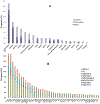Clinical features and biological implications of different U2AF1 mutation types in myelodysplastic syndromes
- PMID: 29057546
- PMCID: PMC9204509
- DOI: 10.1002/gcc.22510
Clinical features and biological implications of different U2AF1 mutation types in myelodysplastic syndromes
Abstract
U2AF1 mutations (U2AF1MT) occur commonly in myelodysplastic syndromes (MDS) without ring sideroblasts. The aim of this study was to investigate the clinical and biological implications of different U2AF1 mutation types in MDS. We performed targeted gene sequencing in a cohort of 511 MDS patients. Eighty-six patients (17%) were found to have U2AF1MT, which occurred more common in younger patients (P = .001) and represented ancestral lesions in a substantial proportion (71%) of cases. ASXL1MT and isolated +8 were significantly enriched in U2AF1MT-positive cases, whereas TP53MT, SF3B1MT, and complex karyotypes were inversely associated with U2AF1MT. U2AFS34 subjects were enriched for isolated +8 and were inversely associated with complex karyotypes. U2AF1MT was significantly associated with anemia, thrombocytopenia, and poor survival in both lower-risk and higher-risk MDS. U2AF1S34 subjects had more frequently platelet levels of <50 × 109 /L (P = .043) and U2AF1Q157 /U2AF1R156 subjects had more frequently hemoglobin concentrations at <80 g/L (P = .008) and more often overt fibrosis (P = .049). In conclusion, our study indicates that U2AF1MT is one of the earliest genetic events in MDS patients and that different types of U2AF1MT have distinct clinical and biological characteristics.
© 2017 Wiley Periodicals, Inc.
Figures






References
-
- Chamseddine AN, Jabbour E, Kantarjian HM, Bohannan ZS, Garcia-Manero G. Unraveling myelodysplastic syndromes: current knowledge and future directions. Curr Oncol Rep. 2016;18:4. - PubMed
-
- Haider M, Duncavage EJ, Afaneh KF, Bejar R, List AF. New insight into the biology, risk stratification, and targeted treatment of myelodysplastic syndromes. AM Soc Clin Oncol Educ Book. 2017;37:480–494. - PubMed
Publication types
MeSH terms
Substances
Grants and funding
LinkOut - more resources
Full Text Sources
Other Literature Sources
Medical
Research Materials
Miscellaneous

